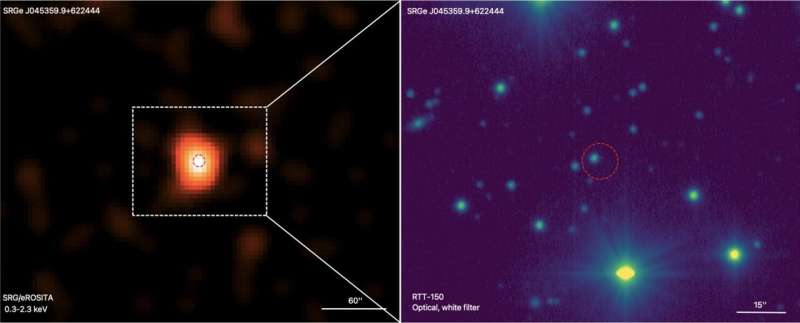July 3, 2023 report
This article has been reviewed according to Science X's editorial process and policies. Editors have highlighted the following attributes while ensuring the content's credibility:
fact-checked
preprint
trusted source
proofread
New eclipsing cataclysmic variable system discovered

Using the Spektr-RG (SRG) spacecraft and the Zwicky Transient Facility (ZTF), an international team of astronomers has discovered a new eclipsing cataclysmic variable system, which received designation SRGeJ045359.9+622444 (or SRGeJ0453 for short). The finding is reported in a paper published June 22 on the pre-print server arXiv.
Cataclysmic variables (CVs) are binary star systems consisting of a white dwarf primary that is accreting matter from a normal star companion. They irregularly increase in brightness by a large factor, then drop back down to a quiescent state. These binaries have been found in many environments, such as the center of the Milky Way galaxy, the solar neighborhood, and within open and globular clusters.
AM CVn stars (named after the star AM Canum Venaticorum), are a rare type of CV in which a white dwarf accretes hydrogen-poor matter from a compact companion star. In general, such systems are helium-rich binaries, not showing traces of hydrogen in their spectra, with orbital periods between five and 65 minutes.
Now, a group of astronomers led by Antonio C. Rodriguez of the California Institute of Technology (Caltech) reports the detection of another AM CVn system as part of a joint SRG and ZTF program to identify cataclysmic variables.
"We have presented the first discovery from a joint SRG/eROSITA and ZTF program to search for CVs and related objects in the Milky Way. SRGeJ0453 is an eclipsing, long period AM CVn system which was identified through its high X-ray to optical flux ratio," the researchers wrote in the paper.
According to the study, SRGeJ0453 is composed of a white dwarf and a donor star that could have initially been a hydrogen star or a helium white dwarf. The donor star was found to have a radius of about 0.078 solar radii and a mass of some 0.044 solar masses, while the mass of the white dwarf accretor was estimated to be approximately 0.85 solar masses.
The observations found that SRGeJ0453 has an orbital period of 55.08 minutes and is located about 780 light years away from the Earth. The X-ray luminosity of the system in the 0.3–2.3 keV energy band was measured to be 620 octillion erg/s.
The astronomers noted that the optical spectrum of SRGeJ0453 shows common features for AM CVn systems, in particular, a blue continuum with prominent helium lines and an absence of hydrogen lines. They added that all lines of neutral helium (He I) have a narrow central absorption commonly seen in nearly edge-on cataclysmic variables and AM CVns among them.
The observations also detected deep eclipses in the optical light curves of SRGeJ0453, as well as low-amplitude flickering, possibly caused by an accretion disk. This makes it the ninth eclipsing AM CVn system discovered to date. The researchers noted that the hard photon index of SRGeJ0453 suggests a possible magnetic nature of this CV; however, this hypothesis needs further studies in order to confirm it.
More information: Antonio C. Rodriguez et al, SRGeJ045359.9+622444: A 55-min Period Eclipsing AM CVn Discovered from a Joint SRG/eROSITA + ZTF Search, arXiv (2023). DOI: 10.48550/arxiv.2306.13133
Journal information: arXiv
© 2023 Science X Network




















